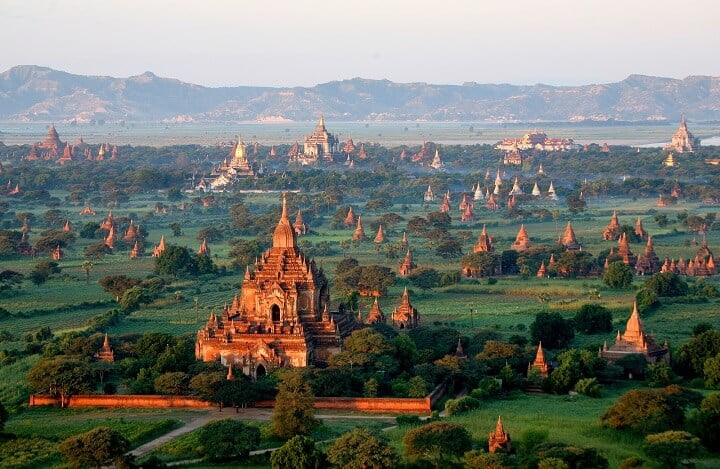By Bipin Dimri | Ancient Mysteries
For a thousand years the interior of Myaymar was home to the Pyu, and their string of cities. Running in a southerly line through the heart of the country, their location traces the course of the Pyu people as they migrated southwards from the foothills of the Himalayas.
The cities of Beikthano, Sri Ksetra, and Halin stretch out along the side of river Irrawaddy, the principal river in the region. The fertile irrigated farmland the river fed saw the rise of villages until the Pyu arrived around 200 BC. These villages in turn supported the great chain of cities the Pyu built here.
The Pyu brought their distinctive culture to the region, heavily influenced by Indian culture through a history of trade. They imported Buddhism, the first time this religion penetrated this region, and many other political, architectural, and cultural features can be traced to India.
These were the earliest Buddhist city-states, which played a crucial role in the transmission of the architectural, ritual, and literary traditions of Pali-based Buddhism. However, only the ruins of this great civilization remain today. What happened to the Pyu city states of Myanmar?
Evidence from the Archaeology
Twelve of the walled cities built by the Pyu in the region have been excavated so far. Out of them, the largest are Beikthano, Binnaka, Maingmaw, Sri Ksetra and Halin. The cities appear to have been inhabited for more than a millennia, seeing continuous occupation from the 2nd century BC to the 11th century AD.
These were transformational for the region, replacing the small agricultural settlements with large cities, containing arts and treasures, monasteries and palaces. These became by far the largest and longest-living urbanized settlements of the region.
Three large cities were initially known before excavations began: Sri Ksetra, Beikthano, and Halin. The remains of these large, moated and brick-walled cities were the first to be investigated.
These cities reflect the existence of Pyu kingdoms around 1000 years ago, between 200 BC and around 900 AD. Beikthano, Sri Ksetra, and Halin can be seen as a single great city running in series along the river, a new urbanization of south east Asia.
The excavations around this site revealed the cultural sophistication the Pyu brought to the area. Buddhist stupas, standing walls, burial grounds, citadels, manufacturing sites, and water management arenas were all uncovered, showing how advanced the cities were.
Such was the sophistication of the engineering that some of the excavated water management features are still in use today, serving the modern intensive agriculture which surrounds the cities. And the excavations are on-going – who knows what other treasures remain to be found in these ancient sites?
The Pyu
The people who built these cities are believed to originate from the shores of Qinghai Lake, the largest lake in modern day China. It is not clear what prompted the migration, but the rich lands to the south must have tempted the Pyu to expand in that direction.
At that time, the main trade route between India and China passed through the north of that region, and the Pyu may have been attracted by the riches of the two great civilizations to their east and west. Their cultural borrowings from India are testament to their frequent contact with these traders.
In the 1st and 2nd century AD, ambassadors from the Roman Empire passed through the region, seeking access to China. The Pyu offered them an alternative route across the Irrawaddy River to their largest city, Sri Ksetra. This placed the Pyu centre-stage for all overland links from the West to China, allowing them to grow rich and prosperous.
Buddhist monastic communities, skilful water management, long-distant trade, and mortuary practice are the major innovations that the Pyu introduced and developed in the region. They transformed Myanmar and made it their new home.
The Downfall of the Pyu
This advantageous position allowed the Pyu to thrive for over 1,000 years. However, the regions they bordered were not so fortunate and experienced much turmoil while the Pyu were content to live in peace.
The downfall of the Pyu, when it came, was sudden. Records describe “swift horsemen” from the Nanzhao region to the north, who conducted small raids on Pyu territory and conquered the upper reaches of the irrawaddy river valley in 763.
However, two massive raids in the first decade of the 9th century caught the Pyu off-guard. The Nanzhao horsemen increased their aggressive incursions and finally overran the Pyu territories entirely in 832.
3,000 Pyu prisoners were taken from the city of Halin alone, and although the Pyu survived this aggression they would never again reach the heights of the preceding centuries. The weakened states were easy prey for the Burmans, a Chinese-Tibetan people to the north.
The defenders were unable to resist the Burmans moving into their territory, and eventually the Pyu were absorbed as the Burmans occupied the Irrawaddy river valley. There they remain to this day.
This relatively passive capitulation saw the end of more than a thousand years of cultural distinctiveness, but it had unexpected benefits for the Pyu. Their surrender allowed much of the architecture of the city states to escape destruction, and there is no sort of indication upon any violent overthrow and Sri Ksetra or any other Pyu site.
So, the Pyu were allowed to survive in exchange for their independence. Much of their culture was diluted and lost but the sophistication and beauty of the cities they built was allowed to endure. Many Pyu ruins still lie unexcavated and even more may be discovered in the future. Who knows what other marvels these peaceful Buddhist traders built, waiting to be found.
This article was originally published by Ancient Mysteries.

